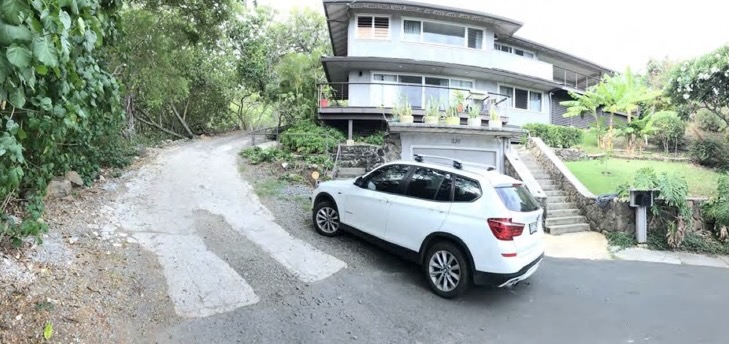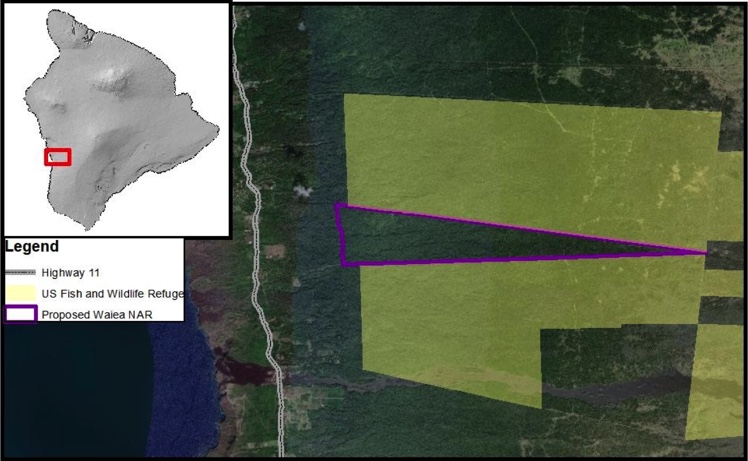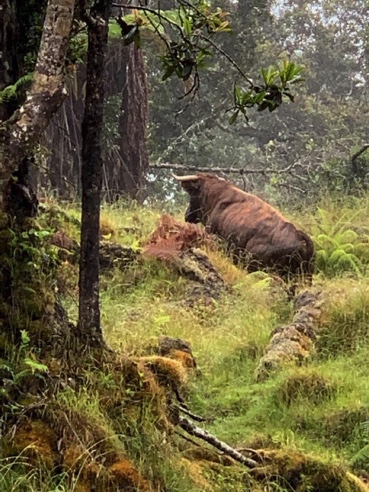“He knew what he was doing,” Land Board member Tommy Oi said in support of his motion to approve a $17,000 fine against Lanikai residents Donald and Julianne King for unauthorized work in the Conservation District.
The couple, who own a hillside home in the area, constructed a rough driveway of thin concrete and gravel and installed landscaping on a 76-acre Conservation District lot adjacent to their own last year, without a permit from the Land Board.
On February 4, the Department of Land and Natural Resources’ Office of Conservation and Coastal Lands (OCCL) recommended fining the couple the maximum fine of $15,000 for the Conservation District violations, plus $2,000 in associated administrative costs.
Shortly after the Kings bought the Conservation District lot in 2012, they wrote to the OCCL inquiring about getting a permit to build a “short paved access road, approximately 140’ long by 12’ wide, with a turn around area at the end.”
Then-OCCL administrator Sam Lemmo informed them that they would need a Conservation District Use Permit from the Land Board and would also need to complete an environmental assessment.
Despite this, in 2016, they submitted an application for a site plan approval for the driveway, not a full CDUP. The OCCL returned the check that accompanied their application and reminded them that they needed to complete an EA and obtain a CDUP from the Land Board for their proposed driveway.
The couple submitted a site plan application for the access again in December 2020, which the OCCL returned in February 2021, with another reminder of what they were required to do.

Finally, last August, the Kings submitted a Conservation District Use Application. However, the photos included in the application showed that the work had already been done.
At the Land Board’s February 4 meeting, the OCCL recommended the Kings pay $17,000 in fines and submit a new CDUA within 180 days.
Donald King apologized to the Land Board and OCCL staff for what had happened.
“I really regret I’m coming before you. … I’m really sorry for the amount of time you guys have had to put into this,” he said.
He explained that in 2012, he and his wife were able to afford buying the Conservation land “because the designation and inability to build a home on the land reduced the value significantly. One of our goals in buying the land was to have it belong to a community member.”
Another goal, he said, was to gain access and a permit for a driveway.
“Our youngest son has autism. My wife and I started a parent support group and founded the Hawaiʻi Autism Foundation,” he added, noting that meetings are sometimes held at their house and that his son has a caregiver visit on regular basis.
“They would have nowhere to park,” he said.
Street parking in Lanikai is highly restricted and is not allowed on three-day weekends.
He said the driveway he built is thin and could be removed with hand tools, if necessary. He added that he would ultimately like to install a proper, permanent cement driveway.
Two of the Kings’ neighbors submitted written testimony in support of their efforts to build a driveway.
Only one member of the public testified at the board meeting. James Manaku, Sr., of Waiʻanae, who often testifies before the Land Board on access issues, expressed his concern over what precedent might be set if the board were to go easy on the Kings.
“What I’m worried about is that if he can do this on his Conservation land, what about the other landowners? … Imagine what can happen on Conservation land on all the islands. … I’m sorry about his predicament, but what is important is our rights and preservation of all these lands,” Manaku said.
Board member Kaiwi Yoon asked King what was going through his mind when he first began building the driveway. “You knew you had to have a permit,” Yoon said.
King again expressed his remorse, and said he was just really slow in applying for the permit. He said he couldn’t afford the cost of hiring a consultant to help him. “I decided to do it myself and I was just really slow in getting it done,” he said.
Board member Vernon Char suggested deferring the violation case and instead allowing the Kings to complete the permitting process.
“I am sympathetic to citizens getting caught in various governmental difficulties. No parking, things of that nature with the city, and just getting gridlocked with procedure. On the one hand I don’t condone self help. … On the other hand I can sympathize with the frustration he has,” Char said.
The OCCL’s Michael Cain said that current Conservation District rules do not allow permits to be processed if there is a pending violation. He added that his office has not asked the Kings to stop using their illegal driveway, but is only seeking fines and a permit.
When board member Oi made a motion to approve the staff’s recommendations as submitted, the board initially approved it 5-2, with Char and board member Doreen Canto voting in opposition.
However, in the middle of holding a roll-call vote to confirm the result, board member Chris Yuen suggested that the board discuss the case further, since some board members had opposed the motion.
Char said, “I think the applicant has come forward. He hasn’t hidden anything. I would go along and vote for this just to get the violation over with but I would reduce the fine to $1,000.”
Yoon disagreed. He recalled King’s statement that he and his wife could afford the land because it was in Conservation.
“Whenever you purchase Conservation land or anything like that, and it’s quite a bit of land, I would hope you would know what the rules and regulations are, the dos and don’ts, and in fact he admitted that he did,” Yoon said.
“Then later, when I asked what was going through your mind, he said, ‘We couldn’t financially afford it.’ To me, that’s, I don’t want to say disingenuous, but it’s schizophrenic,” he added.
Finally, he raised the same point Manaku did. “What’s to stop other owners that have Conservation land who say, ‘Well, I knew, but things weren’t panning out so I did it anyway. Sorry.’?” he asked.
Yuen agreed with Yoon’s arguments and said he could not support a fine as low as $1,000. However, Yuen suggested that the fine should reflect the damage that had been done and said he didn’t think what the Kings had built was as bad as, say, an unauthorized seawall. Yuen said he could support a reduce fine of $10,000 plus the $2,000 in administrative costs.
To Oi, however, the OCCL’s proposed fine was justified.
“He knew he was in violation. OCCL did send him a letter [describing] what he needs to do to get it done and he didn’t do it and he did it on the side, like he’s telling OCCL, ‘We don’t need you. We gon’ do it on our own,’” he said.
In the end, Oi’s motion passed, with Char, Canto, and Yuen voting in opposition.
King said he would not contest the fines.
Feds to Help With Management Of Waiea Natural Area Reserve
Just because lands are in the state Agricultural District doesn’t necessarily mean they’re best used for farming or ranching. That’s the message some Land Board members hoped to convey last month as they voted to enhance management of 1,269 acres in South Kona known as the Waiea Tract.
The Land Board voted last year to set aside the tract as a Natural Area Reserve.
Although the land was once part of a pasture lease, the last permittee surrendered the area, which is surrounded by a National Wildlife Refuge owned by the U.S. Fish and Wildlife Service. There is currently no access to the reserve except through the refuge.

“Waiea is part of a larger contiguous tract of ‘ōhi‘a-dominated forest containing rare forest bird habitat and endangered plant habitat. It is also essential watershed in the central Kona region. The forest in this region has an extraordinarily closed canopy, estimated at 50-75 percent canopy, far above the normal range for native Hawaiian forests. There also is montane mesic forest with mature stands of ‘iliahi,” states a September 2020 report by the Department of Land and Natural Resources’ Division of Forestry and Wildlife supporting the NAR designation.
On February 11, the Land Board unanimously approved a request from DOFAW to authorize the board’s chair to enter into a cooperative agreement with the U.S. Fish and Wildlife Service for management of both the Kona Forest Unit of the Hakalau Forest National Wildlife Refuge and the Waiea Tract.
Such an agreement will allow the FWS and DOFAW to combine their efforts in both areas. “This will be accomplished by coordinating the acquisition and habitat enhancement activity plans and pursuing joint funding opportunities where applicable. Coordinated management and shared resources would prevent duplicating or conflicting land management efforts by developing annual management and maintenance plans cooperatively and sharing annual reports of accomplishments,” DOFAW states.
DOFAW’s Emma Yuen noted that the Waiea Tract was one of the DLNR lands proposed by the Legislature to be transferred to the Department of Agriculture.
“It was mostly used for access. Many years ago, the lessee did not renew their permit and it has just been unencumbered for a long time. It has very limited ag potential because it’s land-locked,” she continued.
“This is a big puka in the protected area in Kona that we’re pulling together,” board chair and DLNR director Suzanne Case added.
Yuen noted that DOFAW already has the materials to fence the area, where feral cattle are still found. “Really soon, we’re going to be able to take care of that,” she said.
Board member Chris Yuen, who also happens to be Emma’s father, said the board’s action regarding Waiea “has some relevance to the ongoing debate at the Legislature about DLNR lands that are under RP [revocable permit] or pasture that have natural resource value. It’s a good example of DLNR moving forward protecting a forest area that was once pasture. … We recognized it should not be grazed [and] now it will be managed as part of a very large contiguous ecosystem along with a Fish and Wildlife Service bird sanctuary in South Kona.”
Currently a number of bills before the Legislature propose to expedite the transfer of lands included in DLNR pasture leases or permits to the DOA.
— Teresa Dawson


Leave a Reply